
The Handley Page HP.137 Jetstream is a small twin-turboprop airliner, with a pressurised fuselage. The aircraft was designed to meet the requirements of the United States commuter and regional airline market. The design was later improved and built by British Aerospace as the BAe Jetstream 31 and BAe Jetstream 32, featuring different turboprop engines.

The Harbin Y-12 is a high wing twin-engine turboprop utility aircraft built by Harbin Aircraft Industry Group (HAIG).

The de Havilland DH.114 Heron is a small propeller-driven British airliner that first flew on 10 May 1950. It was a development of the twin-engine de Havilland Dove, with a stretched fuselage and two more engines. It was designed as a rugged, conventional low-wing monoplane with tricycle undercarriage that could be used on regional and commuter routes. A total of 149 were built; it was also exported to about 30 countries. Herons later formed the basis for various conversions, such as the Riley Turbo Skyliner and the Saunders ST-27 and ST-28.

The Ayres Thrush, formerly the Snow S-2, Aero Commander Ag Commander, and Rockwell Thrush Commander, is an American agricultural aircraft produced by Ayres Corporation and more recently by Thrush Aircraft. It is one of the most successful and long-lived agricultural application aircraft types in the world, with almost 2,000 sold since the first example flew 68 years ago. Typical of agricultural aircraft, it is a single-seat monoplane of conventional taildragger configuration. Originally powered by a radial piston engine, most examples produced since the 1980s have been turboprop-powered.

The Short 330 is a small turboprop transport aircraft produced by Short Brothers. It seats up to 30 people and was relatively inexpensive and had low maintenance costs at the time of its introduction in 1976. The 330 was based on the SC.7 Skyvan. The C-23 Sherpa was a military version of the 330. Production of the aircraft ended in 1992, after 141 were produced. The Short 360 was a development of the Short 330.
The IAR-825 Triumf is a Romanian-designed tandem multirole trainer aircraft based on the IAR-823 built for the Romanian Air Force. The aircraft is roughly in the same class with the Brazilian EMBRAER Tucano. The IAR-825 is equipped with the Canadian Pratt & Whitney Canada PT6 turboprop engine. The type's first flight took place on the 12 June 1982.

The Embraer EMB 121 Xingu is a twin-turboprop fixed-wing aircraft built by the Brazilian aircraft manufacturer, Embraer. The design is based on the EMB 110 Bandeirante, using its wing and engine design merged with an all-new fuselage. The EMB 121 first flew on 10 October 1976.
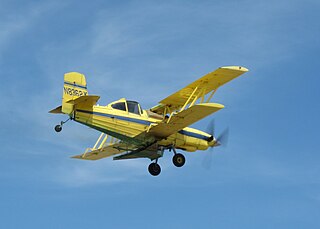
The Grumman G-164 Ag Cat is a single-engined biplane agricultural aircraft, developed by Grumman in the 1950s.

The PZL 130 Orlik is a Polish turboprop, single engine, two seat trainer aircraft.
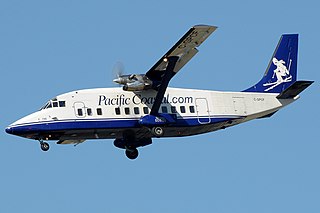
The Short 360 is a commuter aircraft that was built by UK manufacturer Short Brothers during the 1980s. The Short 360 seats up to 39 passengers and was introduced into service in November 1982. It is a larger version of the Short 330.

The Cessna 425, known as the Corsair and later as the Conquest I, is an eight-seat American pressurized turboprop twin-engined light aircraft. Now out of production, it was built by Cessna Aircraft of Wichita, Kansas, between 1980 and 1986.
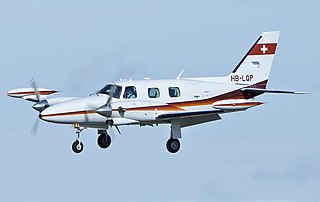
The Piper PA-31T Cheyenne is a turboprop development of the earlier PA-31P Pressurized Navajo.

The Cessna 421 Golden Eagle is an American six or seven seat twin-engined light transport aircraft, developed in the 1960s by Cessna as a pressurized version of the earlier Cessna 411.

The Beechcraft Model 99 is a civilian aircraft produced by Beechcraft. It is also known as the Beech 99 Airliner and the Commuter 99. The 99 is a twin-engine, unpressurized, 15 to 17 passenger seat turboprop aircraft, derived from the earlier Beechcraft King Air and Queen Air. It uses the wings of the Queen Air, the engines and nacelles of the King Air, and sub-systems from both, with a specifically designed nose structure.
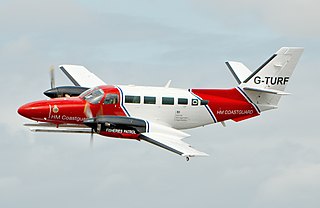
The Reims-Cessna F406 Caravan II is a turboprop twin engine utility aircraft manufactured and designed by Reims Aviation in cooperation with Cessna.

The Aérospatiale N 262 is a French twin-turboprop high-wing airliner built first by Nord Aviation. The aircraft was also known as the Nord 262.
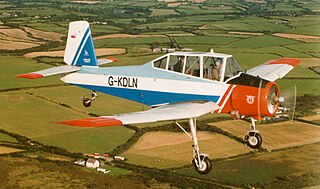
The Zlin Z-37 Čmelák, also known as LET Z-37 Čmelák is an agricultural aircraft which was manufactured in Czechoslovakia. It is powered by a Soviet-built Ivchenko reciprocating engine. The aircraft is used mainly as a cropduster.

The Avtek 400A was an American prototype turboprop-powered business aircraft, which was developed in the early 1980s. Its configuration was unusual and distinctive : a low-wing monoplane with two pusher engines mounted above the wings, and a large canard mounted atop the forward fuselage. The aircraft's sleek, futuristic design earned it a guest appearance on the Airwolf TV series as the X-400, which was used by the villain, Lou Stappleford in the Eagles episode.

The Potez 840 was a 1960s French four-engined 18-passenger executive monoplane, the last aircraft to use the Potez name.

The Conroy Tri-Turbo-Three was a Douglas DC-3 fitted with three Pratt & Whitney Canada PT6A turboprop engines by Conroy Aircraft; the third engine was mounted on the nose of the aircraft.




















